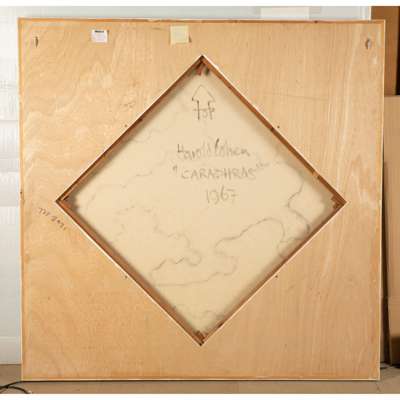
Lot 283

Harold Cohen (British 1928-) §
Caradhras, 1967








Auction: 28 October 2022 from 10:00 BST
Description
signed, titled and dated (to reverse), acrylic on canvas
Dimensions
the canvas 100cm x 100cm (39 3/8in x 39 3/8in)
Provenance
Provenance:
Purchased directly from the Artist in July 1980 from a selling exhibition of his paintings at the Slade School of Fine Art, London prior to his departure to the U.S.A.;
Private Collection, UK.
Footnote
Exhibited:
On long loan to the City Museum and Art Gallery, Birmingham, 1980-6.
Despite being included in all the key exhibition of new British art in the 1960s – including the 1966 Venice Biennale as part of the show Five Young British Artists – Harold Cohen remains less well-known than many of his contemporaries. In part this could be due to his long parallel career in academia at UC San Diego, which began in the late 60s, but it could also be proof that it is possible – just sometimes – to be too far ahead of the curve for your own good, for Cohen has been mapping the worlds of computers and artificial intelligence since the former were a recent invention and the latter didn’t really exist. Indeed, Cohen’s experiments in fully computer-generated art in the 70s and 80s can be seen as crucial early enquiries into AI. He creation of AARON, a computer program designed to produce art autonomously, puts Cohen’s art in a space that is only just being occupied today – although today’s artist programmers seem intent in making their avatars paint figuratively, rather than ask them to evoke something of their own electric dreams.
Carahadras is an imaginary place – the fateful mountain in Tolkein’s Lord of the Rings and Cohen no doubt was aware of Tolkein’s own beautiful maps of his unseen world. Yet everything about this painting – in the colours, in the way its painted – seems the opposite of Tolkein’s feudal, medieval landscape. Carahadras is irrefutably futuristic, diagrammatic – the green and red dots forming their own binary code, on shifting wafers of a motherboard. Yet elements, too, are very much of their time. The deliberate rotation of the square canvas to form a lozenge places the work in line with American minimalism of the same date – the likes of Ellsworth Kelly – and the work’s all over surface, with no real sense of there being a ‘foreground’ or ‘background’ locates the work within Clement Greenberg’s axioms for abstract art. It is therefore very much a 60s painting, albeit one that presages a future that was, at that point, only fiction.








